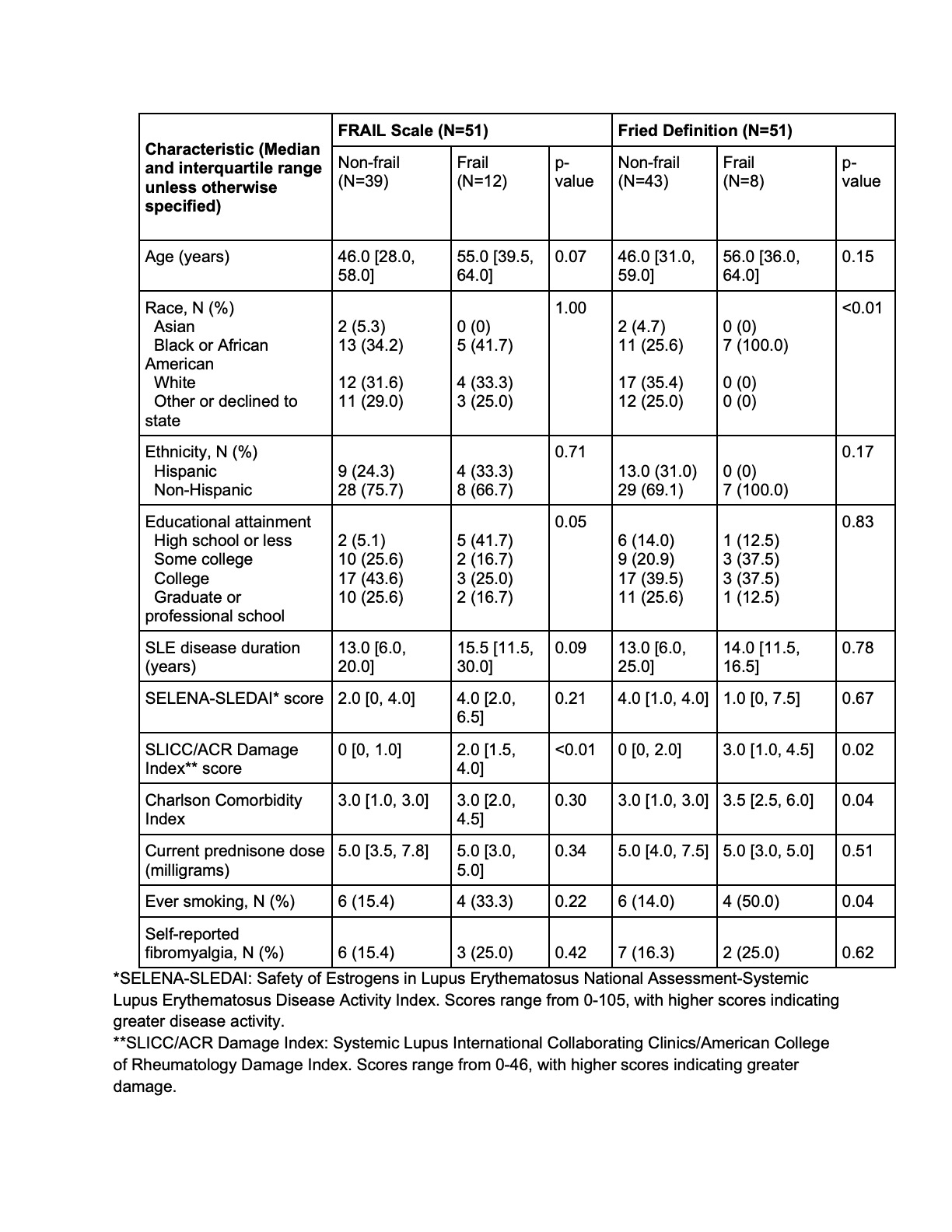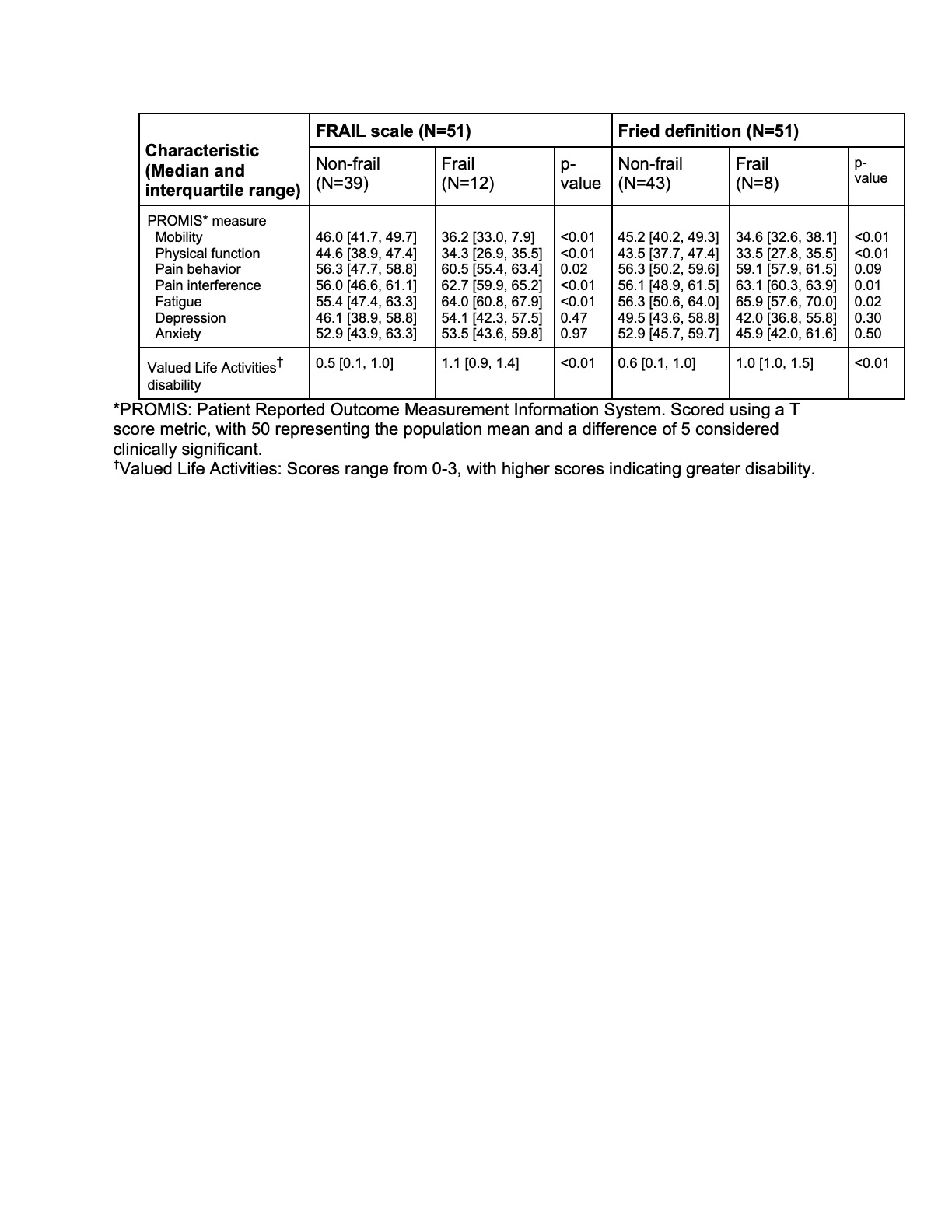Session Information
Date: Monday, November 8, 2021
Title: SLE – Diagnosis, Manifestations, & Outcomes Poster III: Outcomes (1257–1303)
Session Type: Poster Session C
Session Time: 8:30AM-10:30AM
Background/Purpose: Frailty has been associated with disability and mortality in systemic lupus erythematosus (SLE). While frailty is known to be associated with worse patient-reported outcome measures (PROMs) cross-sectionally, the extent to which frailty, particularly the self-reported FRAIL scale (FS) [1], predicts poor health-related quality of life (HRQoL) longitudinally in SLE is not well understood. We aimed to assess the association of baseline frailty according to two validated metrics, the FS and the Fried phenotype (FP) [2], with PROMs at 1 year in a single center prospective cohort of women with SLE.
Methods: Women 18 to 70 years old with SLE validated according to the 1997 Update of the 1982 American College of Rheumatology Revised Classification Criteria and mild or moderate disease activity were identified prospectively at a single center. Multiple measures were obtained at baseline and 1 year, including frailty (FS, an entirely self-reported instrument, and the FP, including objective and self-reported components); physician-reported disease activity and damage; and PROMs (including Patient-Reported Outcomes Measurement Information System (PROMIS) computerized adaptive tests and Valued Life Activities (VLA) self-reported disability). Differences between frail and non-frail participants according to each frailty metric were evaluated using Fisher’s exact or Wilcoxon rank sum tests and the association of baseline frailty with disability (as defined by the upper quartile of VLA scores) at 1 year using logistic regression.
Results: Of 72 women enrolled at baseline, 1-year follow-up data were available for 51 women (71%). Among these 51 women, 24% and 16% were frail at baseline according to the FS and the FP, respectively (Table 1). Frail women had greater disease damage at baseline than non-frail women (FS: p< 0.01; FP: p=0.02); compared to non-frail women, frail women according to the FS had lesser educational attainment (p=0.05) while frail women according to the FP were more often Black or African American (p< 0.01), had greater comorbidity burden (p=0.04), and were more commonly smokers over their lifetime (p=0.04) (Table 1). Women who were frail at baseline had worse PROMIS measures related to mobility (FS and FP: p< 0.01), physical function (FS and FP: p< 0.01), pain interference (FS: p< 0.01; FP: p=0.01), and fatigue (FS: p< 0.01; FP: p=0.02) and greater VLA disability (FS and FP: p< 0.01) at 1 year than women who were not frail at baseline (Table 2). Baseline frailty according to either metric was not associated with VLA disability at 1 year (FS: Odds ratio (OR) 2.1, 95% confidence interval (CI) 0.5-8.9; FP: OR 4.0, 95% CI 0.8-19.5).
Conclusion: Women with SLE who were frail at baseline had worse HRQoL at 1 year than non-frail women. Baseline frailty was not longitudinally associated with self-reported disability at 1 year according to either frailty metric in this small sample of women with SLE. Longitudinal follow-up is underway to determine whether frailty status trajectory may be a more informative predictor of self-reported disability.
References:
1. Morley J et al. J Nutr Health Aging 2012. 16:601-8.
2. Bandeen-Roche K et al. J Gerontol A Biol Sci Med Sci 2006. 61:262-6.
 Table 1. Baseline characteristics of women with SLE by frailty classification
Table 1. Baseline characteristics of women with SLE by frailty classification
 Table 2. Patient-reported outcome measures among women with SLE by frailty classification at 1 year
Table 2. Patient-reported outcome measures among women with SLE by frailty classification at 1 year
To cite this abstract in AMA style:
Lieber S, Nahid M, Rajan M, Barbhaiya M, Sammaritano L, Lipschultz R, Lin M, Mandl L. Longitudinal Association of Baseline Frailty with Patient-Reported Outcome Measures [abstract]. Arthritis Rheumatol. 2021; 73 (suppl 9). https://acrabstracts.org/abstract/longitudinal-association-of-baseline-frailty-with-patient-reported-outcome-measures/. Accessed .« Back to ACR Convergence 2021
ACR Meeting Abstracts - https://acrabstracts.org/abstract/longitudinal-association-of-baseline-frailty-with-patient-reported-outcome-measures/
